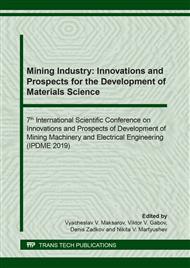[1]
V.Y. Piirainen, Y. Estrin, New Approach to Road Construction in Oil-Producing Regions of Western Siberia, IOP Conf. Ser. Earth and Environmental Sci. 87(7) (2017).
DOI: 10.1088/1755-1315/87/7/072003
Google Scholar
[2]
Gray J. Malcolm, Niobium bearing steels in pipeline projects, Niobium science and technology, Proc. Int. Symposium on Niobium (Orlando, Florida, 2–5 Dec. 2001).
Google Scholar
[3]
S.A. Golovanenko, New steels and technological schemes for the production of a thick plate for gas pipes of large diameter, Metals, 5 (2002) 36–46.
Google Scholar
[4]
N. Bannenberg Recent developments in steelmaking and casting, Niobium science and technology, Proc. Int. Symposium on Niobium (Orlando, Florida, 2–5 Dec. 2001).
Google Scholar
[5]
K.Yu. Shakhnazarov, D.V. Chechurin, On the nature of osmondite, Notes of the Mining Instit. 227 (2017) 554–557.
Google Scholar
[6]
Yu.D. Morozov, L.I. Efron, Steel for pipes of main pipelines: state and development trends, Metallurg, 5 (2006).
Google Scholar
[7]
A.A. Nemtinov, A.M. Korchagin, A.G. Popkov et al., Mastering the production of K70 strip for large-diameter pipes at mill 5000, Metallurg 11 (2008) 61–67.
DOI: 10.1007/s11015-009-9117-4
Google Scholar
[8]
M. Hamada Control of strength and toughness at the heat affected zone, Welding int. 17(4) (2003) 265–270.
DOI: 10.1533/wint.2003.3100
Google Scholar
[9]
Y. Shi, Z. Han, Effect of weld thermal cycle on microstructure and fracture toughness of simulated heat-affected zone for a 800 MPa grade high strength low alloy steel, J. Mater. Proc. Technol. 207 (2008) 30–39.
DOI: 10.1016/j.jmatprotec.2007.12.049
Google Scholar
[10]
V.I. Kiryan, L.I. Mikhoduy, The problems of using new steels of increased and high strength in welded structures, Automatic welding 3 (2002) 10–17.
Google Scholar
[11]
H.-G. Hillenbrand, M. Gras, C. Kalwa, Development and production of high strength pipeline steels, Niobium sci. and technol., Proc. Int. Symp. on Niobium (Orlando, Florida, 2–5 Dec. 2001).
Google Scholar
[12]
S. Meimeth, F. Grimpe, H. Meuser, Development, state of the art and future trends in design and production of heavy plates in X80 steel grades, Steel Rolling 2006, 9th Int. & 4th European Conf. (Paris, France, 19–21 June 2006).
Google Scholar
[13]
A.N. Bortsov, I.P. Shabalov, A.A. Velichko et al., Features of multi-electrode welding under a flux layer in the production of high-strength thick-walled pipes, Metallurg 4 (2013) 69–76.
DOI: 10.1007/s11015-013-9730-0
Google Scholar
[14]
A.A. Velichko, A.N. Bortsov, I.P. Shabalov et al., The relationship of thermal processes with the morphology of welded joints and promising types of welding in relation to thick-walled electric-welded pipes, Metallurg 3 (2014) 72–77.
DOI: 10.1007/s11015-014-9891-5
Google Scholar


